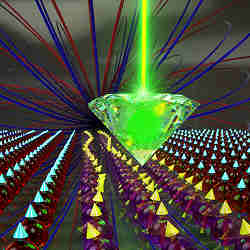
Over the past 60 years, semiconductor chips have become smaller, cheaper, and more powerful, and their proliferation has enabled the ubiquitous computing we enjoy today. Intel founder Gordon Moore suggested in 1965 that improvements in manufacturing techniques would allow overall processing power for computers to double approximately every two years as the number of transistors on each integrated circuit doubled, an observation that became known as Moore's Law.
However, the ability to keep shrinking transistors and squeezing ever more onto silicon chips is reaching its physical limit.
"As Moore's law comes to an end, one can no longer rely on device shrinking to enhance system performance from one generation to the next," says Sachin Sapatnekar, a professor in the Department of Electrical and Computer Engineering at the University of Minnesota, and an ACM Fellow. Sapatnekar says an intensive search is under way for alternatives that could drive systems in the post-CMOS (complementary metal oxide semiconductor) era (CMOS technology is used in the transistors that are in most of today's microchips).
A wrinkle in the search for alternatives, Sapatnekar says, lies in the fact that emerging applications are fundamentally different and require different computational capabilities from those afforded by traditional CMOS processors.
A strong alternative emerging to CMOS-based chips is spintronics (shorthand for "spin electronics"), a technology that works by manipulating the spin of electrons, instead of relying solely on their charge. Spintronic devices can offer higher computing speeds and storage capacities, at lower power consumption, than CMOS chips.
Sapatnekar says spintronic devices provide novel computational capabilities using mechanisms that differ from those offered by CMOS-based structures.
Ron Mertens, editor-in-chief of the Spintronics-Info.com news hub and knowledge center, explains, "If we think of each electron as a small planet, it has two ways it can rotate: up and down. We can then label the up-spin as '1' and the down-spin as '0'. If you can control the spin of an electron, and also read it, and also retain it, you can use this in memory devices."
Sapatnekar points out that spintronic devices are fundamentally nanomagnetic structures, and store information in a magnetic orientation state, which does not change when the power is turned off. This non-volatility allows spintronic structures to easily map to memory devices.
"In environments where data retention is important, especially in the face of power disruptions, these products will have a significant advantage," says John Fruehe, director of marketing at Everspin Technologies, a semiconductor company spun out of Freescale Semiconductor that is a leading provider of magneto-resistive random-access memory (MRAM) spin-based chips that store data in magnetic states, instead of as electrical charges as dynamic random-access memory (DRAM) does.
Fruehe points out that in the financial sector, an interruption in power might require remedial action as simple as spending hours trying to sort out a customer's brokerage account to rectify the missing data, or as complex as a multimillion dollar fine for non-compliance in logging transactions.
"The greater the business impact of lost data, the more valuable MRAM becomes," Fruehe says, "and in situations like vehicle navigation or aerospace control where missing data can have catastrophic impacts, high-speed non-volatile memory like MRAM is essential."
Primary verticals that will take advantage of MRAM products include the aerospace, finance, industrial, military, and enterprise storage sectors, according to Fruehe.
Sapatnekar says spin-based technologies are still evolving, and there is a natural evolution that they must go through before they reach maturity. "Process technologies are still immature. Newer spin-based device mechanisms are continually being explored," he says, "and leveraging these in novel devices can potentially offer a path to continued performance improvement over time, playing a role similar to technology scaling in CMOS."
Device prices are still high, and development is a challenge for chips based on spintronics, according to Mertens, who says some applications could take years to get to market. Mertens expects to see major growth in MRAM devices, adding, "This will probably lead the spintronics market in the near future."
In Sapatnekar's view, a hybrid CMOS-spintronic chip may be an interim path to market, although spintronics-based switches (which he defined as "transistor-like structures created to be a one-for-one replacement for CMOS logic gates") still do not offer the same energy/delay performance as CMOS for digital logic applications. Sapatnekar feels CMOS will be hard to displace in digital applications, and any successor technology will need to not only match CMOS performance, but to exceed it sufficiently to justify retooling the supply chain.
John Delaney is a freelance writer based in Manhattan, NY.



Join the Discussion (0)
Become a Member or Sign In to Post a Comment